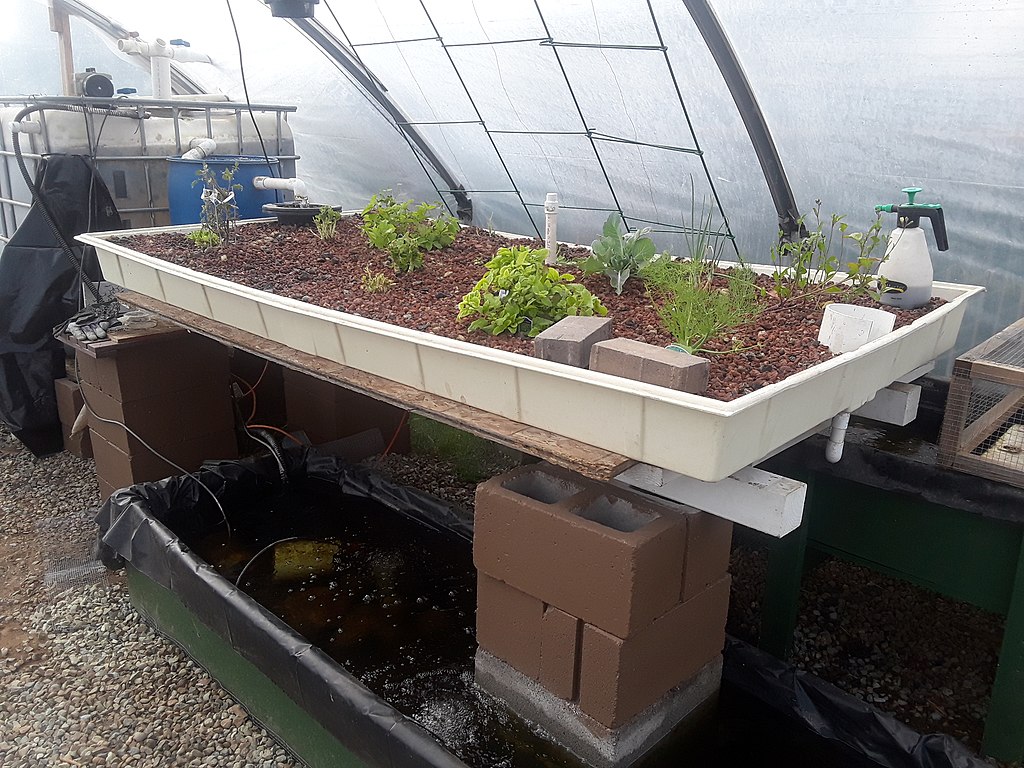Contents [hide]
Hydroponics
Introduction
How do you take advantage of small spaces? In a vertical city, consider vertical gardening. Traditional gardening requires land with soil. A vertical garden can also be more efficient with hydroponics instead of soil based systems.
What is Hydroponics?
Hydroponics is a method of growing plants without soil, using a nutrient-rich solution and a growth medium to support the roots. This comes with some of the following benefits:
- Faster growth rates
- Higher yields
- Reduced water consumption
- Controlled environment
- Year-round production
Types of Hydroponic Systems
Kratky
The Kratky system is the simplest and passive hydroponic system where the plant is placed in a net cup in a basin of nutrient solution. A head space is needed so the plants do not drown. As the nutrient mixture is consumed, transpired and evaporated, careful consideration of adding nutrients must be taken in order to avoid drowning the air roots.

Deep Water Culture
Deep Water Culture Image by jwynia (CC-BY)
Deep Water Cultures modify the Kratky technique by introducing air pumps in a large volume of nutrient solution. A modification of this technique can be found in floating raft applications. The bubbling of nutrients oxygenates the system while also aerosolizing it to promotes fine root structures to enhance nutrient absorption.
Floating Raft Image by Oregon State University (CC-BY-SA)
Aeroponics
Aeroponics is a system where the roots are exposed with a fine mist of nutrient as opposed to being submerged in them. A modification of this technique is fogponics where the nutrient mixture is turned into a fine fog. The idea behind these techniques is to aerosolize the nutrient mixture to be the appropriate size for the roots to take up and maintain a high humidity without bathing the roots.
Ebb & Flow/ Flood & Drain
Nutrient solution periodically floods and drains the growing medium. This utilizes a pump coupled to a bell siphon.

Ebb & Flow system by Joshuamaddox (CC-BY-SA 4.0)
Nutrient Film Technique (NFT)
A thin film of nutrient solution flows continuously over the plant roots.

Dutch Bucket/Bato Bucket
Plants requiring deeper root support can utilize the Dutch Bucket where the growth media are drip fed with nutrient and drains.
Vertical Systems
Vertical systems take advantage of the different styles to enhance the density of the grow space. Tower gardens can work via ebb & flow, aeroponics or continuous feed.



Growing Media
Traditional farming houses roots within soil. This in turns provides the drainage and support for the plant. Inert media must take over this role for hydroponics. Various inert media will not alter the pH or the dissolved substances in the nutrient media over time.
Rockwool Cubes
Like the name implies, Rockwool is a type of spun fiber from rock. It has excellent water retention properties and can be used for germination for easy placement within a final growout system.

Coconut Coir
Fiber derived from dried out coconut husks can be packed into cubes or mixed with other minerals like perlite and vermiculite. It can often appear like soil when amended this way. Perlite is a volcanic glass that adds to the aeration of the medium while vermiculite is a mineral that retains moisture.
Expanded clay pebbles
Expanded clay pebbles are inert and light compound often placed into net cups to support the plants. They do not retain water so they require constant access to a nutrient mixture.

Nutrient Solutions
- Key nutrients: Nitrogen, phosphorus, potassium, calcium, magnesium, sulfur, and micronutrients.
- Nutrient formulas: Commercial hydroponic nutrient solutions and DIY recipes.
- Importance of pH and EC: Maintaining optimal pH and electrical conductivity levels for nutrient uptake.
| Crops | EC (mS/cm) | pH |
| Asparagus | 1.4 to 1.8 | 6.0 to 6.8 |
| Basil | 1.0 to 1.6 | 5.5 to 6.0 |
| Bean | 2.0 to 4.0 | 6 |
| Banana | 1.8 to 2.2 | 5.5 to 6.5 |
| Broccoli | 2.8 to 3.5 | 6.0 to 6.8 |
| Cabbage | 2.5 to 3.0 | 6.5 to 7.0 |
| Capsicums | 0.8 to 1.8 | 5.5 to 6.0 |
| Celery | 1.8 to 2.4 | 6.5 |
| Cucumber | 1.7 to 2.0 | 5.0 to 5.5 |
| Eggplant | 2.5 to 3.5 | 6 |
| Leek | 1.4 to 1.8 | 6.5 to 7.0 |
| Lettuce | 1.2 to 1.8 | 6.0 to 7.0 |
| Okra | 2.0 to 2.4 | 6.5 |
| Pak Choi | 1.5 to 2.0 | 7 |
| Parsley | 1.8 to 2.2 | 6.0 to 6.5 |
| Spinach | 1.8 to 2.3 | 6.0 to 7.0 |
| Strawberry | 1.8 to 2.2 | 6 |
| Sage | 1.0 to 1.6 | 5.5 to 6.5 |
| Tomato | 2.0 to 4.0 | 6.0 to 6.5 |
Lighting
- Types of lighting:
- Fluorescent lights
- Metal halide lamps
- High-pressure sodium (HPS) lamps
- LED lights
- Light spectrum and intensity requirements:
- Red and blue light for photosynthesis
- Adequate light intensity for optimal growth
Temperature and Humidity
- Ideal temperature range: 65-75°F (18-24°C)
- Humidity control: Maintaining appropriate humidity levels to prevent diseases and optimize plant growth.





